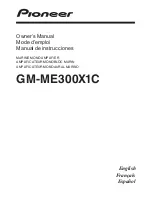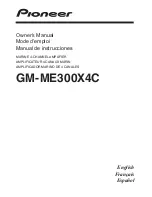
44
Equalizer settings using the
Test CD
Introduction
Room resonance effects can lead to over-emphasis (exaggeration) as well as
under-emphasis in the frequency response at the listening position. Over-
emphasis is generally perceived as much more unpleasant and disturbing
(droning) than under-emphasis, which is often quite difficult to detect when
music is played.
In the procedure described below various test-signals are played back from the
Test CD. Since the left and right speakers excite the room in different
ways, the following tests and settings must be carried out separately for the left
and right channels. For this reason all the tracks on the CD are duplicated, i.e.
one set for the left channel, one for the right channel.
Procedure
Before starting the procedure please switch off Loudness, Tone and
Room Correction.
(see chapter 'Tone control settings - room correction')
Take up your normal listening position.
Start with track 1 (right channel: track 21), which consists of broad-band pink
noise, and set the volume to an elevated room level. Do not alter the volume
during the remainder of the procedure.
Caution!
do not alter the volume even if you hear no sound at all while the
first tracks are played, otherwise there is a risk that the loudspeakers could
be damaged by low-frequency signals.
Each of the following tracks 2 to 20 (right channel: 22 to 40) contains two
sine-wave signals whose frequencies correspond to one of the equalizer
settings. First the lower frequency is played, then the higher frequency, after
which they alternate (25 Hz and 30 Hz, 30 Hz and 35 Hz, 35 Hz and 40 Hz
etc.).
Locate the measurement sheet supplied in the set, and mark in the top table
- by ticking the corresponding field - whether the higher frequency is
much
quieter, slightly quieter, equally loud, slightly louder or much louder
than the
lower frequency.
For example: if you listen to track 4 (35 Hz and 40 Hz) and the higher
frequency is louder than the lower one, then tick the
louder
row in the
40 Hz
column. Repeat the procedure until you reach 200 Hz. As you can see, there
is already a tick at 25 Hz: this is the reference frequency at which you begin.
Any object which rattles (e.g. doors, wine glasses) will affect your ability to
judge the volume, and will tend to falsify the results. Please cure the problem
before you proceed.
Assessment
The next step is to start the assessment process using the bottom table on the
measurement sheet. Place a tick in the 25 Hz column in the row which was
closest to your impression when listening (please observe the notes in the
table). If the top table contains more ticks above
equally loud
than below it,
place the first tick in the bottom table further down (and vice versa).
Now take the next frequency from the top table, and add the value in the first
column next to the volume description to the value in column 1 of the bottom
table in the row where you placed the tick. Example: in the bottom table you
placed the tick for 25 Hz at -4. If 30 Hz is
slightly louder
than 25 Hz, then add
+1, and place the tick for 30 Hz in the -3 row. If 35 Hz (the next frequency) is
also
slightly louder
than 30 Hz, then place the tick for 35 Hz in the -2 row, and
so on. Continue this procedure up to 200 Hz. In the bottom table you can now
read off the frequency response for the left (right) channel at your listening
position.
Tip:
you can place the first tick (25 Hz) even more accurately if you add
together all the values from the top table, and use this in inverse form as the
starting point in the bottom table. For the table in the example this would be:
(0 +0 +1 +3 +3 -1 -3 +1 +0 +0 +0 +0 +3 -3 + 0 +0 +1 -1 +0 +1) * -1 =
-5
Содержание P 3000 HV
Страница 2: ...2 ...
Страница 22: ...22 ...
Страница 50: ...50 ...
Страница 61: ...61 Anschluss Schema Wiring diagram H Link ...
Страница 62: ...62 Anschluss Schema Wiring diagram Surround Decoder 1 Triggerleitung optional trigger connection optional ...
Страница 64: ... elektroakustik GmbH Co KG Herford Deutschland Germany ...
















































